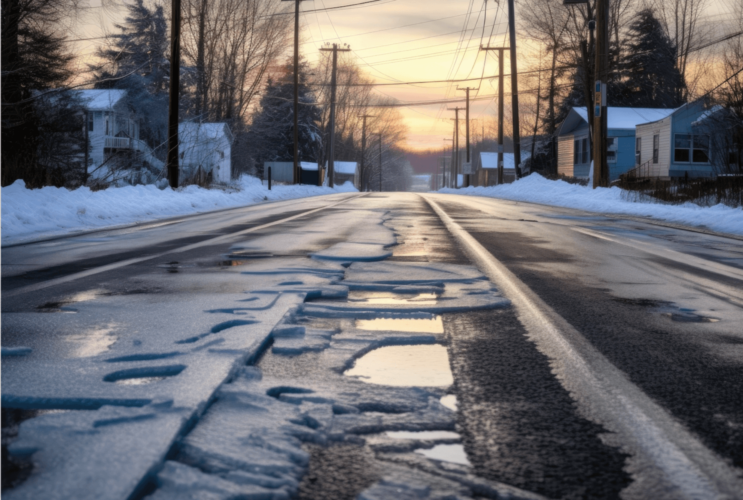
Driving in New England: How to Protect Yourself from Winter Potholes
Winter in New England brings picturesque landscapes and a sense of wonder. However, it also presents a notorious challenge on the roads – potholes. These road hazards can cause significant damage to vehicles, leaving drivers frustrated and with unexpected repair bills. As a responsible driver, it is crucial to understand the impact of potholes on your vehicle and take the necessary precautions to protect yourself.
Potholes are a common occurrence during the winter in New England. The freezing and thawing cycles combined with rain and traffic wear down the asphalt, creating cracks and weak spots. As vehicles pass over these weakened areas, the weight and force cause the pavement to break, forming potholes. These potholes can range in size and depth, posing a threat to vehicles and their occupants.
Hitting a pothole can result in various types of damage to your vehicle. The severity of the damage depends on factors such as the size and depth of the pothole, the speed of impact, and the condition of your vehicle’s suspension and tires. Common types of pothole-related damage include:
- Tire damage: Potholes can cause punctures, bulges, or sidewall damage to your tires, leading to reduced performance and the need for replacement.
- Wheel and rim damage: The impact of hitting a pothole can bend or crack your wheel rims, affecting the tire’s seal and potentially causing air leakage.
- Suspension damage: Potholes can place significant stress on your vehicle’s suspension system, leading to misalignment, bent control arms, or damaged shocks and struts.
- Steering system damage: Hitting a pothole can affect your vehicle’s steering components, resulting in difficulty steering or a feeling of instability.
- Exhaust system damage: Potholes can cause the exhaust system to scrape against the road, leading to potential leaks or damage to pipes and mufflers.
Tips for Avoiding Pothole-Related Damage
Keep Your Eyes on the Road
Vigilance is key to avoiding potholes altogether. By keeping your eyes on the road ahead, you can spot potholes early and navigate around them safely. Be particularly cautious after recent warm-ups and during rainstorms, as puddles can disguise potholes, making them harder to spot. If you notice vehicles ahead of you slowing down or swerving, it may indicate the presence of a pothole.
Slow Down and Maintain a Safe Distance
If you find yourself unable to avoid a pothole, reducing your speed can minimize the impact and potential damage to your vehicle. Slow down and approach the pothole with caution, allowing your vehicle’s suspension to absorb the impact more effectively. Additionally, maintaining a safe distance from the vehicle ahead gives you more time to react and avoid potholes if they suddenly appear.
Vigilance During Rainstorms and Warm-Ups
Rainstorms and warm-ups can exacerbate the formation and visibility of potholes. During these weather conditions, exercise extra caution and be prepared for sudden changes in road conditions. Puddles can fill up potholes, making them harder to spot. Stay alert and adjust your driving accordingly to minimize the risk of pothole-related damage.
Troubleshooting Signs of Damage
After encountering a pothole, it is essential to assess your vehicle for any signs of damage. Promptly addressing minor issues can prevent them from escalating into major and costly problems. Look out for the following signs that may indicate pothole damage:
- Vehicle pulling to one side: If your vehicle tends to drift or pull to one side after hitting a pothole, it could indicate misalignment or suspension damage.
- Steering difficulties: Difficulty steering or a feeling of the steering “slipping” may suggest damage to your vehicle’s steering components caused by a pothole.
- Continued bouncing: If your vehicle continues to bounce excessively after going over a bump or dip, it could be a sign of suspension damage.
- Unusual tire behavior: Keep an eye out for tires that stray or shake, as this may indicate tire or wheel damage resulting from a pothole encounter.
Minor Repairs to Prevent Major Issues
If you notice any signs of damage, it is advisable to address them promptly. Ignoring minor issues can lead to more significant and costlier problems down the road. Consult a qualified mechanic or auto repair shop to assess and repair the damage. Taking care of minor repairs promptly can help extend the lifespan of your vehicle and prevent further damage from developing.
Navigating the Complex Relationship Between Potholes and Insurance
Filing an Insurance Claim
When faced with pothole-related damage, you may consider filing an insurance claim to cover the repair costs. However, the relationship between potholes and insurance can be complex. Most insurance policies require evidence that the damage was caused by something other than normal wear and tear. Additionally, hitting a pothole is generally considered an at-fault incident until proven otherwise. However, if there is damage beyond the tire itself you may be covered if you have collision insurance for greater damages such as suspension and exhaust damages.
Seeking Reimbursement from Municipalities
In some cases, you may consider seeking reimbursement from municipalities for pothole-related damage. However, this process can be challenging. In Massachusetts, for example, municipalities are required to have prior knowledge of a pothole or road defect and a reasonable amount of time to fix it to be held liable. Unfortunately, reimbursement from municipalities is typically rare.
Capturing the Evidence
If you encounter significant pothole damage and decide to file an insurance claim, documenting the damage and the pothole itself is crucial. Take clear and detailed photographs of your vehicle’s damage, including close-ups of affected areas. Additionally, capture images of the pothole, noting its size and location. These visual records serve as valuable evidence when submitting your claim.
Notifying the Department of Public Works
To further support your claim, notify the Department of Public Works or Highway Department about the pothole. Providing this information helps authorities identify and address road hazards promptly, potentially preventing future incidents for other drivers. By reporting the pothole, you contribute to the overall safety of the roadways in your community.
Safety NorthEast Insurance Agency: Your Trusted Partner in Automobile Insurance
When it comes to automobile insurance, Safety NorthEast Insurance Agency is here to assist you. As a trusted insurance provider, we offer both personal and commercial automobile insurance coverage. Our dedicated team is ready to help you navigate the complexities of pothole-related incidents, from providing quotes to assisting with claims and answering general questions. We prioritize your safety and peace of mind on the road, offering comprehensive coverage tailored to your needs.
As winter continues in New England, potholes become an inevitable challenge for drivers. By understanding the impact of potholes on your vehicle, following preventative measures, and securing the right automobile insurance coverage, you can minimize the risk of damage and unexpected expenses. Remember to stay vigilant on the road, promptly address any signs of damage, and document incidents for potential insurance claims. With Safety NorthEast Insurance Agency by your side, you can confidently navigate the winter roads and protect yourself from road hazards.

 Previous Post
Previous Post Next Post
Next Post